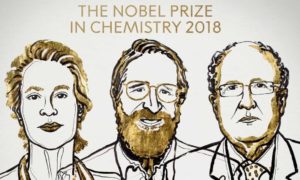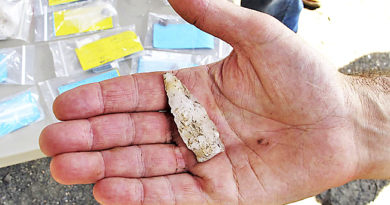2018 NOBEL CHEMISTRY PRIZE: Frances H Arnold, George P Smith and Gregory P Winter win Nobel prize in chemistry

Briton and two Americans honoured for using evolutionary principles to develop proteins that have been used in new drugs and medical treatments
RELATED STORY:
COLUMBIA, Missouri (AP) — The University of Missouri is honouring its Nobel Prize-winning scientist with an unusual accolade: a dedicated spot in a bicycle rack.
George Smith learnt this month that he will share this year’s Nobel Prize in chemistry with two other scientists.
Other schools have recognised their Nobel laureates with a dedicated parking space. But the 77-year-old Smith is, by his own assessment, “not a good driver”.
Smith told The Kansas City Star he’s no “bike enthusiast” but that he lives less than a mile from the Columbia campus and bikes to work every day.
His spot will be in a standard bike rack, the same as those used by other bicyclists on campus. But the university plans to post a sign letting everyone know one particular space belongs to a Nobel laureate.

George Smith (chemist)
| George Smith | |
|---|---|
| Born | George Pearson Smith[1] March 10, 1941 Norwalk, Connecticut, U.S. |
| Residence | Columbia, Missouri |
| Education | |
| Known for | Phage displays |
| Spouse(s) | Marjorie Sable[2] |
| Scientific career | |
| Fields | |
| Institutions |
|
| Thesis | The variation and adaptive expression of antibodies. (1970) |
| Doctoral advisor | Edgar Haber |
George Pearson Smith (born March 10, 1941)[3][4] is an American biologist and Nobel laureate.[5] He is a Curators’ Distinguished Professor Emeritus of Biological Sciences at the University of Missouri in Columbia, Missouri.
Contents
Career
Born in Norwalk, Connecticut, he earned his A.B. degree from Haverford College in biology, was a high school teacher and lab technician for a year, and earned his Ph.D.degree in bacteriology and immunology from Harvard University.[6] He was a postdoc at the University of Wisconsin (with future Nobel laureate Oliver Smithies) before moving to Columbia, Missouri and joining the University of Missouri faculty in 1975. He spent the 1983–1984 academic year at Duke University with Robert Webster where he began the work that led to him being awarded a Nobel Prize.[7][8][9][2][10]
He is best known for phage display, a technique where a specific proteinsequence is artificially inserted into the coat protein gene of a bacteriophage, causing the protein to expressed on the outside of the bacteriophage. Smith first described the technique in 1985 when he displayed peptides on filamentous phage by fusing the peptide of interest onto gene III of filamentous phage.[8] He won the 2018 Nobel Prize in Chemistry for this work, sharing his prize with Greg Winter and Frances Arnold.
Smith is an advocate for equal rights for Palestinians and Israeli Jews in their common homeland, and a strong supporter of the Boycott, Divestment and Sanctions movement.[11]
Awards and honors
- 2000 University of Missouri Curators’ Professor[12]
- 2001 Elected Fellow – AAAS[12]
- 2007 Promega Biotechnology Research Award[13]
- 2018 Nobel Prize in Chemistry together with Greg Winter and Frances Arnold[14
 All photographs, news, editorials, opinions, information, data, others have been taken from the Internet..aseanews.net | [email protected] / For comments, Email to : Aseanews.Net | [email protected]
All photographs, news, editorials, opinions, information, data, others have been taken from the Internet..aseanews.net | [email protected] / For comments, Email to : Aseanews.Net | [email protected]









